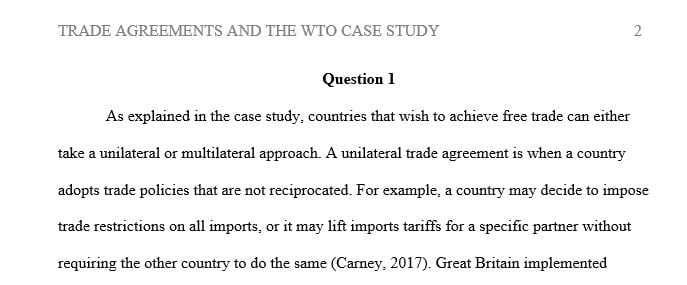Describe the difference between a unilateral and multilateral trade agreement
CASE STUDY UNIT 3- Trade Agreements and the World Trade Organization, Case Study – Page 181
Trade Agreements and the World Trade Organization
A country can take one of two approaches to achieving free trade. It can take a unilateral approach and remove its trade restrictions on its own. This is the approach that Great Britain took in the 19th century and that Chile and South Korea have taken in recent years. Alternatively, a country can take a multilateral approach and reduce its trade restrictions while other countries do the same. In other words, it can bargain with its trading partners in an attempt to reduce trade restrictions around the world.
One important example of the multilateral approach is the North American Free Trade Agreement (NAFTA), which in 1993 lowered trade barriers among the United States, Mexico, and Canada. Another is the General Agreement on Tariffs and Trade (GATT), which is a continuing series of negotiations among many of the world’s countries with the goal of promoting free trade. The United States helped to found GATT after World War II in response to the high tariffs imposed during the Great Depression of the 1930s. Many economists believe that the high tariffs contributed to the worldwide economic hardship of that period. GATT has successfully reduced the average tariff among member countries from about 40 percent after World War II to about 5 percent today.
The rules established under GATT are now enforced by an international institution called the World Trade Organization (WTO). The WTO was established in 1995 and has its headquarters in Geneva, Switzerland. As of 2015, 162 countries have joined the organization, accounting for more than 97 percent of world trade. The functions of the WTO are to administer trade agreements, provide a forum for negotiations, and handle disputes among member countries.
What are the pros and cons of the multilateral approach to free trade? One advantage is that the multilateral approach has the potential to result in freer trade than a unilateral approach because it can reduce trade restrictions abroad as well as at home. If international negotiations fail, however, the result could be more restricted trade than under a unilateral approach.
In addition, the multilateral approach may have a political advantage. In most markets, producers are fewer and better organized than consumers—and thus wield greater political influence. Reducing the Isolandian tariff on textiles, for example, may be politically difficult if considered by itself. The textile companies would oppose free trade, and the buyers of textiles who would benefit are so numerous that organizing their support would be difficult. Yet suppose that Neighborland promises to reduce its tariff on wheat at the same time that Isoland reduces its tariff on textiles. In this case, the Isolandian wheat farmers, who are also politically powerful, would back the agreement. Thus, the multilateral approach to free trade can sometimes win political support when a unilateral approach cannot.
Carney, J. (2017). Trade agreements and the World Trade Organization. In N.G. Mankiw, Principles of macroeconomics (p. 181). Boston, MA: Cengage.
Please submit a two- page paper, double spaced with proper APA citations.
Please review the The Case Study Grading Rubric to learn how grade will be calculated.
Students are encouraged to use the library resources (linked below) to research their papers.
Case Study Assignment: Submit a paper answering the following questions:
1. Describe the difference between a unilateral and multilateral trade agreement.
2. Give 2 examples of a multilateral trade approach.
3. How is NAFTA classified ?
Answer preview to describe the difference between a unilateral and multilateral trade agreement

APA
610 words


